In the first blog article in this two-part series, we took a closer look at two models for the course of change processes. These models showed how such processes ideally proceed in order to successfully address change. They thus provide valuable implications for practice, especially with regard to leadership and communication. In the second part, we now look at three further theories that are relevant to the successful implementation of change.
Before making any significant change, a company must first be aware of which approach is the right one in the prevailing context. As indicated in the previous article, not all change processes need to be initiated top-down, but can also be bottom-up or a mixture of both instead.
Approaches for change
Top-down
Probably the best known and most widespread approach is the top-down approach. Here, the changes are initiated by the top management, which is responsible for planning and implementation, as well as setting an example for the vision. Employees are then expected to implement these changes based on instructions. The problem is that this approach often meets with significant resistance. Over time, employees develop a comfort zone that they are reluctant to leave, and if they do, then only with resistance. A further disadvantage of this approach can be that the vision that has been lived out is distorted by employees at the lowest level of the hierarchy.
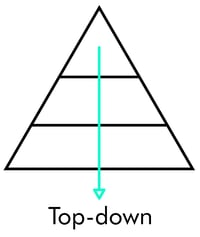
Bottom-up
In contrast to the top-down approach, this change process here is initiated by employees at the lowest level of the hierarchy and then moves upwards toward the top management. One advantage of this approach is that the lower levels of the hierarchy know best where changes are needed and which ones could be the most effective. However, employees at this level of the hierarchy will usually not move too far out of their comfort zone mentioned above and won’t initiate such changes proactively. In addition, they often lack the necessary expertise to initiate and manage complex change processes.
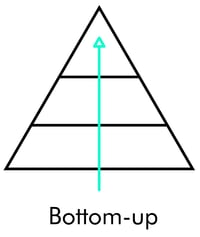
Both directions
The both directions approach is a mixture of top-down and bottom-up approach and thus offers the advantages of both approaches and avoids their disadvantages. Employees at the lowest level of the hierarchy do not feel disadvantaged, which in turn leads to less resistance. In practice, this can be implemented in various ways. For example, lower-level managers could look for drivers for change during the interaction with employees. They can then match the inputs and ideas of the employees with the change requests from top management. In this way, solutions can be developed step by step that fit everyone.
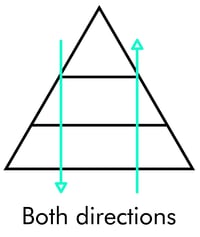
Multiple Nucleus
The last possible approach is the multiple nucleus approach. In contrast to the other approaches, here the changes start simultaneously at several locations in the company. When all departments have implemented the changes, the change process is completed. It is obvious that this approach can quickly lead to chaos, as it is time-consuming to coordinate. In hierarchies that do not allow for vertical implementation, however, this approach can be quite helpful, as implementation must then take place horizontally and at several areas simultaneously.
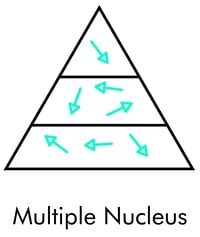
Top-down and both directions are most frequently used in practice. Pure bottom-up and multiple nucleus approaches are rare in comparison. As a rule of thumb, only as much top-down as necessary and as much bottom-up as possible should be chosen. In the best-case scenario, requests for change come from both top management and employees at the lowest level of the hierarchy and are discussed and implemented together.
Formula for change by Dannemiller and Jacobs
In 1992, two academics developed a formula to calculate how likely it is that a change can be successfully implemented. This formula is also often used in practice by consulting firms.
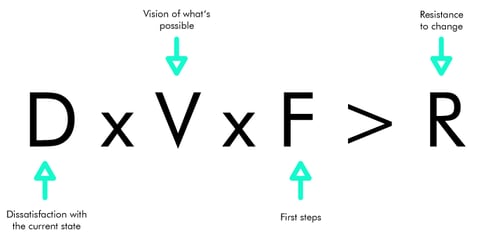
On the right side of the equation is the resistance to change. On the left side are the following three factors:
- D – Dissatisfaction with the status quo
- V – Vision of what’s possible
- F – First concrete steps that can be taken to realize the vision
If the product on the left side is larger than R, the implementation of a change is possible. Since the three factors on the left are multiplied, if one factor is zero, the product is zero. So, if one of the three factors were zero, the resistance would be too great to overcome.
According to the formula, the following conditions are necessary to ensure successful change:
- Communication of a clear vision of what is possible
- Identification of decisive first steps towards vision
- Identify dissatisfaction: Listen to the voice of employees and share industry trends, best practices and competitive analysis to communicate the need for change
7-Phase Model by Richard Streich
At the end of this two-part blog series we will have a look at one last model. It’s all about emotional reactions. As already mentioned, far-reaching changes can trigger strong reactions and resistance from those affected. According to Streich, emotional reactions to major, sudden changes take place in seven phases. This model is less relevant for smaller or less surprising changes, as well as for changes that have been worked out through the involvement of employees.
The course of the emotional reaction is important for change management in order to communicate adequately and adapt the management style. If you know the phases that employees go through, you can plan them in advance.

In the first phase, employees are confronted with the necessary changes and typically react in shock. Fear, surprise and lack of understanding oftentimes also reduce employee productivity.
This is followed by a phase of rejection. Experienced employees mobilize and consciously speak out against the change for fear of the new and the loss of the familiar corporate culture.
After the initial rejection, the employees gradually show understanding for the change. They realize that the change cannot be prevented and may even be necessary. At this point, however, the employees are not yet ready for personal change.
The low point and also the turning point in the 7-Phase Model is emotional acceptance. In addition to the rational understanding, employees now also begin to accept the change emotionally and are inwardly ready to tread new paths.
This is followed by the phase of trying new things, which is characterized by curiosity. New ways of behavior are explored, whereby mistakes are made again and again. This trial and error methodology is an important element of this phase.
After the employees have successfully implemented the first behavioral patterns, they realize that the changes make sense and can be implemented.
The final phase of the model is the integration of the new structure and behaviors into everyday life. Through the success of the change, the employees become more self-confident, which can lead to an increase in performance. Gradually, a new routine is thus formed.
The models presented in the two parts thus provide, at least to some extent, answers to known questions in relation to change management. They can be used to present complex processes in a simplified way and thus provide a better overview and more clarity. Furthermore, they provide valuable implications for communication and leadership during change processes and hopefully they also provide inspiration for contextualization in your company.
